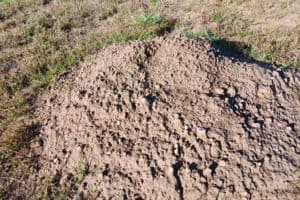Longtime local journalist Bill Radford and his wife, Margaret, live on 5 acres in the Falcon area with chickens, rabbits, dogs, cats, two noisy parrots, goats and two horses. Contact Bill at billradford3@gmail.com
That was the excited observation by our daughter, then in college, when she first saw our little house on the prairie. It was meaningful to her, I assume, because that road cemented the fact that we were truly out in the country. (The horses in the backyard, of course, were another clue.)El Paso County has about 1,150 miles of gravel roads; they’re divided into 23 distinct maintenance areas, varying in size from 20 miles to 90. That maintenance falls to staff with the county Department of Public Works who are responsible for resurfacing, ditching and the profiling of gravel roads.”Most gravel roads are maintained on a six to eight week schedule,” the county website states. ìSection line roads and higher traffic roads receive more attention.”While that schedule is the goal, Scot Cuthbertson, director of Public Works, said that regular maintenance is more like 12 to 14 weeks.”Our road network gets bigger every year, and we get more spread out every year,” he said. Tackling that growing system is a limited combination of resources in the form of workers, material and equipment.The system of roads is not only expanding, but also, of course, aging. “Sometimes, the maintenance on these roads, as they age, it takes longer than we’d like,î Cuthbertson said.Some roads, like one recently in my neighborhood, are targeted for more than regular maintenance.”About 18 months ago, we started a process called reclamation, which is an industry best practice,” he said. îEssentially, it is the equivalent to putting a new surface on a paved road.”During the process, extensive drainage work is done, then the “reclaimer” ó a big, yellow piece of equipment ó goes to work mixing gravel and magnesium chloride into the surface of the road along with new material. ìBasically, we gain about six to eight more years of life with that roadway,î Cuthbertson said.How do they know which roads are most in need of work? That information comes from the grader operator in each area.”Those grader operators are basically our scouts in the field,” Cuthbertson said. “They are very familiar with the condition of their roadways and they report back to their chain of command on where to do certain treatments. Then we rack and stack those based on need and availability of resources.”The county website explains the purpose of regular maintenance: “The goal when working gravel roads is to re-establish a ‘crown’ or cross slope to the roadway, address drainage issues with the ditches, and to regrade the surface to remove washboards and improve the overall condition.”Not having traveled extensively on gravel roads before, the problem of “washboards” ó a wavy pattern on the road resembling an old-fashioned metal washboard ó was new to me when we moved out here.I turned to Howstuffworks.com for an explanation.”While washboard roads are familiar to drivers on country roads around the world, the phenomenon occurs elsewhere in science and technology,î the site states. “Whenever a sideways force acts on a malleable surface, ripples occur. You may have seen the same little ripple on wind or water-driven sand at the beach and on moguls that develop on ski hills. Motocross bikes and snowmobiles also cause ripples to form in dirt and snow.””That’s just a part of the natural life of a gravel road,” Cuthbertson said of washboarding.”What causes most of it is people driving too fast. Ö People are traveling 15, 20, 25 miles over the posted speed limit. It causes like a ripple effect on the road.”A lack of moisture aggravates the problem as well, he said. îWater will help you shape the road, but once that moisture evaporates, if that material is older and more broken down, it will come right back.”The county does have water trucks to help wet down the roads, but only four. So they don’t go very far when you have over a thousand miles of road to maintain, Cuthbertson noted.Mother Nature sometimes lends a hand, though. “What we do is if we get rain or snow, the operators will go out and take advantage of that moisture to help shape the roadway.”More information on the county’s roadways can be found online at https://publicworks.elpasoco.com/road-bridge/gravel-roads.”We are trying to be more transparent, so we’re putting more and more information on the life of a gravel road and things like that on the internet for people to research,” Cuthbertson said. “And we’re trying to be more transparent about where we’re working, when we’re working.”You can go to publicworks.elpasoco.com for the road maintenance schedule. If you feel your road is in dire need of attention, Cuthbertson recommends going to https://citizenconnect.elpasoco.com to create a service request.






